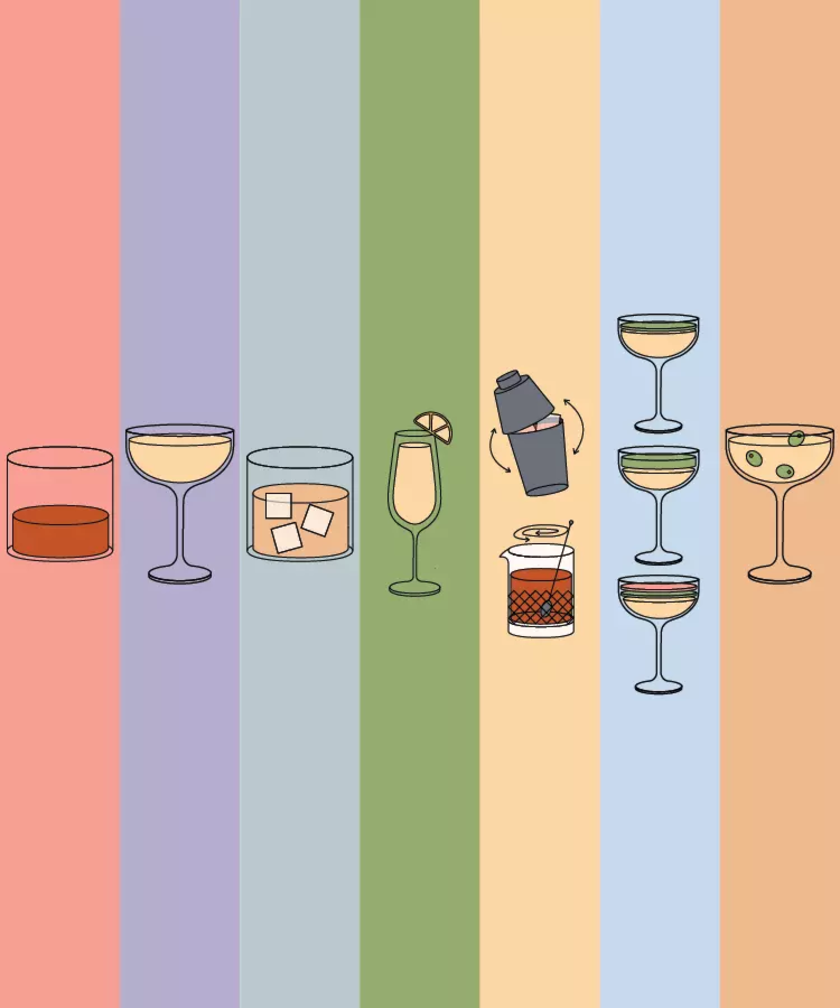
Cocktail Terminology to Know to Sound Like a Pro
Brush up on your cocktail lingo or learn new drink terminology with The Bar's guide to bar lingo.

Learn basic cocktail terminology and recommended spirits and glass shapes. Brush up on terms like "neat," "up," "on the rocks," "with a twist," "shaken vs. stirred," and "wet," "dry" or "perfect" vs. "dirty" martinis.
Cocktail language can seem intimidating for those new to the bar scene, but there’s no need to be nervous. We’ve decoded common bar buzzwords so you can feel confident ordering or mixing up your favorite cocktails. Use this cocktail lingo primer to impress your friends or to let your bartender know exactly how you like your drink.
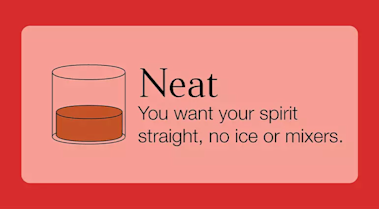
What does “Neat” mean?
What it is: A neat drink is a spirit without mixers or ice
Why it’s important: Neat drinks allow a spirit’s complex flavors to shine
A drink served “neat” is a simple pour of the spirit straight. This preparation (or lack thereof) is the purest way to experience a spirit since it’s sipped with zero added mixers, ice, garnishes or water to affect the taste. “Neat” drinks are sipped and savored, usually from a rocks glass (with no ice) and are a favorite way to enjoy premium-level spirits, especially whiskeys.

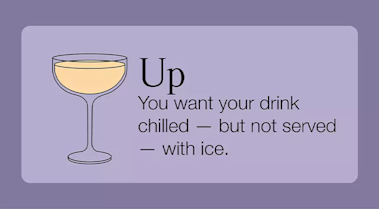

What does served "Up" mean?
What it is: A drink served up is chilled but does not contain ice
Why it’s important: An up drink is cool without being diluted
Order your drink “up” if you want it chilled — but not served — with ice. “Up” drinks are prepared by shaking or stirring ingredients in a cocktail shaker or mixing glass with ice until they are well chilled. Then, the mixture is poured through a cocktail strainer into a glass, usually a coupe or martini glass, before serving. This allows the drink to be served chilled without being diluted by ice in the glass. Popular cocktails served “up” are cosmopolitans and other types of martinis.
Cocktails served up
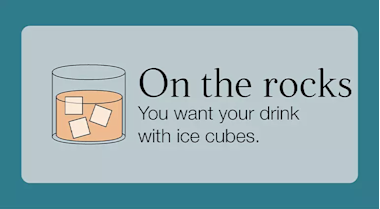
What is a drink "On the rocks"?
What it is: A drink that is on the rocks is served with ice cubes
Why it’s important: Ice will cool a drink, but may dilute it
“On the rocks” is another way of saying with ice cubes. A great example of this is when you order a margarita “on the rocks” instead of frozen. This is how most basic mixed drinks are served since the melting ice doesn’t affect the overall drink too much. Vodka crans, whiskey and cola and gin and tonics are served this way, usually in a rocks or highball glass, while spritzes are typically served “on the rocks” in wine glasses.

Cocktails served on the rocks
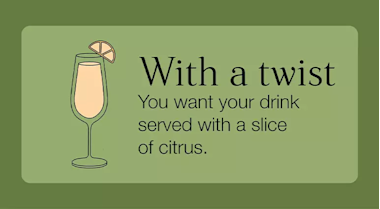
What does "With a twist" mean?
What it is: A twist is a slice of citrus rind added to a cocktail
Why it’s important: A slice will add citrus flavor and visual interest to a drink
For drinks “with a twist”, bartenders often peel off a section of an orange, lemon, lime or other citrus fruit’s rind and literally twist it just above the glass to release the peel’s essential oils. Then, they add the peel to the cocktail. This adds an extra aromatic and faint citrus flavor to the cocktail. Cosmopolitans, old fashioneds and palomas are common drinks served “with a twist”. Twist drinks are served in a variety of glassware ranging from martini and coupe glasses to rocks and highball glasses. It all depends on the drink.

Cocktails served with a twist
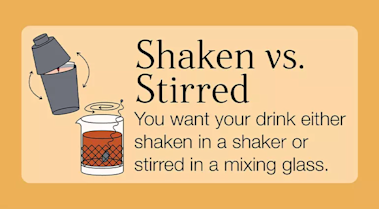
Shaken vs. stirred
What it is: Shaken drinks are prepared in a cocktail shaker and stirred drinks are swirled in a glass, often with a cocktail spoon
Why it’s important: A shaken drink will be more diluted than a stirred drink
A certain secret agent has made these two styles of cocktail preparation famous (although his preference for a martini “shaken”, not “stirred”, has stirred up quite the debate among bar professionals). When a cocktail is “shaken”, it’s mixed in a shaker with ice and shaken vigorously until chilled. Shaking with ice partially dilutes the overall flavor of the cocktail, affects drink clarity and can produce froth. “Stirred” cocktails are mixed more gently with a cocktail spoon, leaving the cocktail undiluted and appearing clearer in the glass after being poured. Most commonly, coupe or martini glasses are used for shaken or stirred cocktails.

Cocktails served shaken & stirred
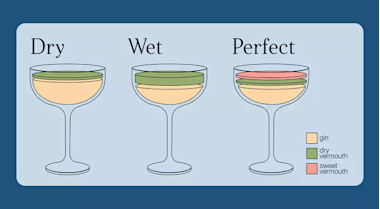
"Dry", "wet" & "perfect" Types of Martinis
What it is: A dry martini highest ratio of gin to dry vermouth, a wet martini has more dry vermouth, and a perfect martini has equal parts dry and sweet vermouth
Why it’s important: Different styles of martini may require different ingredients and measurements
Several iterations of the martini exist — espresso, vodka, Manhattan, to name a few — but the O.G. martini is simply a drink made of gin, dry vermouth and a garnish, usually an olive, cocktail onion or citrus twist. The difference between a “dry”, “wet” and “perfect” martini depends on the gin-to-vermouth ratio. A “dry” martini calls for a 5:1 ratio of gin to dry vermouth, while a “wet” martini includes a larger quantity of vermouth, mixed in 2:1 ratio of gin to dry vermouth. The “perfect” martini follows the same 2:1 ratio but splits the vermouth component to contain equal parts dry and sweet vermouth. The classic “V’” shaped martini glass may be one of the most recognizable types of cocktail glassware behind the bar, though bartenders may also use a curvy coupe glass for serving martinis.

Alternative martini glassware
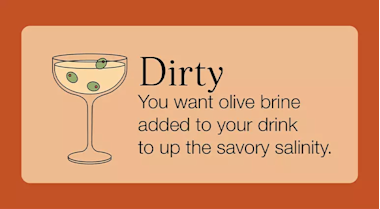
"Dirty" Martini
What it is: Olive brine is added to a martini for a salty kick
Why it’s important: This is a classic variation on a martini for fans of umami flavors
One of the most popular ways to order a martini is “dirty”. This simply means there’s olive brine added to the drink to up the savory salinity. “Dirty” martinis are served in martini glasses with an odd number of olives as a garnish. You can get creative by using olives stuffed with different kinds of goodies like blue cheese, garlic or pimento.

You know how you like your favorite cocktail served — now you know how to ask for it like a pro, so next time you can order your drink with confidence just the way you like it.